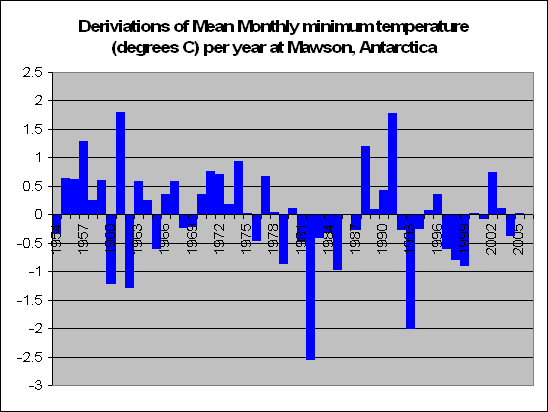Mass gains from accumulating snow, particularly on the Antarctic Peninsula and within East Antarctica, exceed the ice dynamic mass loss from West Antarctica. The result exacerbates the difficulty of explaining twentieth century sea-level rise.
This of course is very interesting to me, and we do have some data from some Australian stations out on the cold continent. So lets see analyse the data from there. Mawson is a place named after Australian explorer Sir Douglas Mawson. Unfortunately they only have max and min data down there, and whilst I hate analysing data where the time isn’t kept constant, we shall give it a go anyway.
 The graph on the left shows deviations from the average minimum temperature at Mawson from 1954. Tests prove no significant increase or decrease (F = 2.22, p = 0.14). And the graph below shows deviations from the average monthly maximum temperature, of which tests again show no significant increase or decrease (F = 0.07, p = 0.79).
The graph on the left shows deviations from the average minimum temperature at Mawson from 1954. Tests prove no significant increase or decrease (F = 2.22, p = 0.14). And the graph below shows deviations from the average monthly maximum temperature, of which tests again show no significant increase or decrease (F = 0.07, p = 0.79).
So there is little wonder why the ice is increasing at Antarctica. Admittedly, this is only one station on the whole continent, so we can probably only conclude that around the Mawson side of Antarctica, it’s not heating up, which backs up the British survey’s results.
So don’t worry too much peoples, looks like there will still be a few more march of the penguins documentaries to come out in the future.

8 comments:
How big is the 95% confidence interval for the trend in this case?
+/-10°C per century? :)
Min: -0.01 +/- 0.015
Max: 0.0016 +/- 0.013
Insignificant. The p value is all you really need
So per century this is:
min: -1.0 +/- 1.5
Max: 0.16 +/- 1.3
According to climate scientists global average temperatures have increased by 0.6 ± 0.2 °C over the 20-th century.
Your results are thus utterly irrelevant.
Count Iblis, are my results irrelevant, or are the others irrelevant? It's so easy to discard the results you don't agree with. Either way, prove me wrong or else, admit the fact that Australia (not the world) is not warming up
Jonathan,
as long as 0.6 ± 0.2 °C per century falls within you confidence interval, your results are not in conflict with the hypothesis that Australia, Antarctica etc. are warming according to the rate observed by climate scientists for the Earth.
It may well be that Australia is not warming at the rate the rest f the world is, but so far you haven't shown that.
You need to reduce your standard deviation by a factor of ten, so I guess you need to average over 100 times more measurements to get meaningful results.
I'm not doubting that the rest of the world is warming up at all. I'm just saying that Australia and parts of Antarticia are not at all.
"You need to reduce your standard deviation by a factor of ten, so I guess you need to average over 100 times more measurements to get meaningful results."
I agree. Lets wait another 100 years until we have ample data to test. Because at the moment, there is no proof of global warming in Australia, let alone if it is human caused, let alone if action will help, let alone if warming isn't advantageous....
The potential problems casused by global warming at any given place have little to do with the mere fact that at that place it will be a few degrees warmer.
If you eliminate problems of station drop out and make take out the fudge factors in the USHCN than North America hasn't warmed either. I wonder where all the heat is? Maybe it's hiding.
Post a Comment